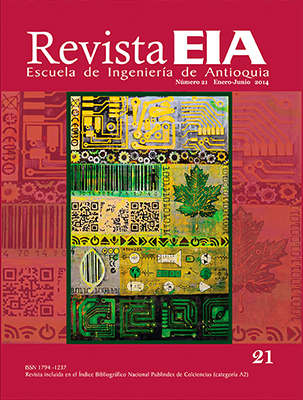EVALUACIÓN DEL RIESGO EN SISTEMAS DE DISTRIBUCIÓN DE AGUA POTABLE EN EL MARCO DE UN PLAN DE SEGURIDAD DEL AGUA
EVALUACIÓN DEL RIESGO EN SISTEMAS DE DISTRIBUCIÓN DE AGUA POTABLE EN EL MARCO DE UN PLAN DE SEGURIDAD DEL AGUA
Barra lateral del artículo
Términos de la licencia (VER)

Esta obra está bajo una licencia internacional Creative Commons Atribución-NoComercial-SinDerivadas 4.0.
Declaración del copyright
Los autores ceden en exclusiva a la Universidad EIA, con facultad de cesión a terceros, todos los derechos de explotación que deriven de los trabajos que sean aceptados para su publicación en la Revista EIA, así como en cualquier producto derivados de la misma y, en particular, los de reproducción, distribución, comunicación pública (incluida la puesta a disposición interactiva) y transformación (incluidas la adaptación, la modificación y, en su caso, la traducción), para todas las modalidades de explotación (a título enunciativo y no limitativo: en formato papel, electrónico, on-line, soporte informático o audiovisual, así como en cualquier otro formato, incluso con finalidad promocional o publicitaria y/o para la realización de productos derivados), para un ámbito territorial mundial y para toda la duración legal de los derechos prevista en el vigente texto difundido de la Ley de Propiedad Intelectual. Esta cesión la realizarán los autores sin derecho a ningún tipo de remuneración o indemnización.
La autorización conferida a la Revista EIA estará vigente a partir de la fecha en que se incluye en el volumen y número respectivo en el Sistema Open Journal Systems de la Revista EIA, así como en las diferentes bases e índices de datos en que se encuentra indexada la publicación.
Todos los contenidos de la Revista EIA, están publicados bajo la Licencia Creative Commons Atribución-NoComercial-NoDerivativa 4.0 Internacional
Licencia
![]()
Esta obra está bajo una Licencia Creative Commons Atribución-NoComercial-NoDerivativa 4.0 Internacional
Contenido principal del artículo
Resumen
RESUMEN
La evaluación del riesgo es una etapa clave de un Plan de Seguridad del Agua (PSA) y se logra mediante la identificación de peligros o eventos peligrosos y la valoración del riesgo. Este estudio evaluó los riesgos en el Sistema de Distribución de Agua potable (SDA) de la ciudad de Cali (Colombia) abastecido por el río Cauca, identificando los eventos peligrosos y posteriormente realizando la estimación del riesgo usando una matriz semicuantitativa adaptada. La estimación del riesgo se efectuó inicialmente sin considerar las medidas de control existentes del SDA y luego se reestimó considerando el nivel de eficacia de las mismas. Los resultados mostraron los eventos con mayor nivel de riesgo asociados al deterioro de la integridad física e hidráulica del SDA (daños en tuberías, fluctuaciones de presión, ausencia de información sistematizada sobre el SDA, fallas humanas, falta de capacitación, supervisión, conciencia del concepto aseguramiento del agua, corrosión interna y externa de elementos del SDA). La evaluación del riesgo es un instrumento de gestión para empresas prestadoras del servicio que permite priorizar recursos humanos y financieros hacia el mejoramiento de las medidas de control como estrategia para reducir los riesgos y asegurar la calidad del agua potable en el SDA.
ABSTRACT
The riskassessment is a key stage in a Water Safety Plan (WSP) and it is achieved by the identification of hazards or hazardous events and the riskestimation. This study evaluated the health risks in the Drinking Water Distribution System (DWDS) of the city of Cali (Colombia) which is supplied by the Cauca River; the hazardous events were identified and subsequently the riskestimation was made using a semi-quantitative riskmatrix, previously adapted. The riskestimation was made initially without considering the existing control measures in the DWDS and then, the risks were re-estimated considering the level of effectiveness of them. The results showed the events with the highest level of riskassociated with the loss of physical and hydraulic integrity of the DWDS (damage to water pipelines, pressure fluctuations, lackof systematic information on the DWDS, human failures, and lackof training, supervision and awareness about the concept of safety drinking water, internal and external corrosion in the elements of the DWDS). The riskassessment is a management tool for water providers which allow prioritizing the human and financial resources toward improving the control measures as a strategy to reduce health risks and ensure the quality of drinking water in the DWDS.
Descargas
Detalles del artículo
Claudia Patricia Amézquita Marroquín, Universidad del Valle
Ingeniera sanitaria. MsC. en Ingeniería, énfasis Ingeniería Sanitaria y Ambiental, Universidad del Valle. Asistente de investigación Grupo de Investigación Estudio y Control de la Contaminación Ambiental, Universidad del Valle. Cali, Colombia.
Andrea Pérez Vidal, Universidad de Boyacá
Ingeniera Sanitaria. Ph.D. en Ingeniería, Énfasis en Ingeniería Sanitaria y Ambiental, Universidad del Valle. Profesora Titular Facultad de Ciencias e Ingeniería, Universidad de Boyacá, Colombia
Patricia Torres Lozada, Universidad del Valle
Ingeniera Sanitaria, Universidad del Valle. PhD. en Ingeniería Civil, énfasis Hidráulica y Saneamiento, Universidad de São Paulo, Brasil. Profesora Titular, Universidad del Valle. Grupo de Investigación Estudio y Control de la Contaminación Ambiental, Universidad del Valle. Cali, Colombia.
Artículos similares
- Christian Andrés Diaz-León, Edwin Mauricio Hincapié-Montoya, Edison Andrés Guirales-Arredondo, Gustavo Adolfo Moreno-López, DISEÑO Y DESARROLLO DE UN SISTEMA DE INTERACCIÓN PARA SU IMPLEMENTACIÓN EN UN AULA DE CLASE INTELIGENTE , Revista EIA: Vol. 13 Núm. 26 (2016)
También puede {advancedSearchLink} para este artículo.


 PDF
PDF
 FLIP
FLIP


